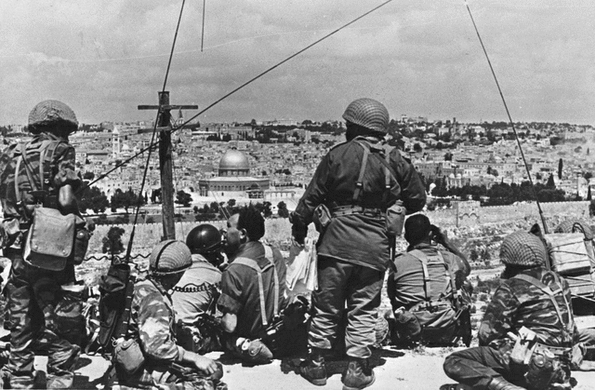The Six-Day War
(June 5 - 10, 1967)
"Israel consistently expressed a desire to negotiate with its neighbors. In an address to the UN General Assembly on October 10, 1960, Foreign Minister Golda Meir challenged Arab leaders to meet with Prime Minister David Ben-Gurion to negotiate a peace settlement. Egyptian President Gamal Abdel Nasser answered on October 15, saying that Israel was trying to deceive world opinion, and reiterating that his country would never recognize the Jewish State.
In 1963, the Arab League decided to introduce a new weapon in its war against Israel — the Palestine Liberation Organization (PLO). Its leader, Yasser Arafat, would become the PLO chairman and most visible symbol. The groups adhered to a set of principles laid out in the Palestine National Charter, which called for Israel's destruction.
On May 15, Israel's Independence Day, Egyptian troops began moving into the Sinai and massing near the Israeli border. By May 18, Syrian troops were prepared for battle along the Golan Heights. On May 22, Egypt closed the Straits of Tiran to all Israeli shipping. This blockade cut off Israel's only supply route with Asia and stopped the flow of oil from its main supplier, Iran.
On June 5, 1967, Israel was indeed alone, but its military commanders had conceived a brilliant war strategy. The entire Israeli Air Force, with the exception of just 12 fighters assigned to defend Israeli air space, took off at 7:14 a.m. with the intent of bombing Egyptian airfields while the Egyptian pilots were eating breakfast. In less than 2 hours, roughly 300 Egyptian aircraft were destroyed. A few hours later, Israeli fighters attacked the Jordanian and Syrian air forces, as well as one airfield in Iraq. By the end of the first day, nearly the entire Egyptian and Jordanian air forces, and half the Syrians’, had been destroyed. The battle then moved to the ground, and some of history’s greatest tank battles were fought between Egyptian and Israeli armor in the blast-furnace conditions of the Sinai desert.
By the end of the war, Israel had conquered enough territory to more than triple the size of the area it controlled, from 8,000 to 26,000 square miles. The victory enabled Israel to unify Jerusalem. Israeli forces had also captured the Sinai, Golan Heights, Gaza Strip and West Bank."
- The Jewish Virtual Library
"Israel consistently expressed a desire to negotiate with its neighbors. In an address to the UN General Assembly on October 10, 1960, Foreign Minister Golda Meir challenged Arab leaders to meet with Prime Minister David Ben-Gurion to negotiate a peace settlement. Egyptian President Gamal Abdel Nasser answered on October 15, saying that Israel was trying to deceive world opinion, and reiterating that his country would never recognize the Jewish State.
In 1963, the Arab League decided to introduce a new weapon in its war against Israel — the Palestine Liberation Organization (PLO). Its leader, Yasser Arafat, would become the PLO chairman and most visible symbol. The groups adhered to a set of principles laid out in the Palestine National Charter, which called for Israel's destruction.
On May 15, Israel's Independence Day, Egyptian troops began moving into the Sinai and massing near the Israeli border. By May 18, Syrian troops were prepared for battle along the Golan Heights. On May 22, Egypt closed the Straits of Tiran to all Israeli shipping. This blockade cut off Israel's only supply route with Asia and stopped the flow of oil from its main supplier, Iran.
On June 5, 1967, Israel was indeed alone, but its military commanders had conceived a brilliant war strategy. The entire Israeli Air Force, with the exception of just 12 fighters assigned to defend Israeli air space, took off at 7:14 a.m. with the intent of bombing Egyptian airfields while the Egyptian pilots were eating breakfast. In less than 2 hours, roughly 300 Egyptian aircraft were destroyed. A few hours later, Israeli fighters attacked the Jordanian and Syrian air forces, as well as one airfield in Iraq. By the end of the first day, nearly the entire Egyptian and Jordanian air forces, and half the Syrians’, had been destroyed. The battle then moved to the ground, and some of history’s greatest tank battles were fought between Egyptian and Israeli armor in the blast-furnace conditions of the Sinai desert.
By the end of the war, Israel had conquered enough territory to more than triple the size of the area it controlled, from 8,000 to 26,000 square miles. The victory enabled Israel to unify Jerusalem. Israeli forces had also captured the Sinai, Golan Heights, Gaza Strip and West Bank."
- The Jewish Virtual Library
